Oldsmobile Cutlass Supreme
- See also: Oldsmobile Cutlass
| Oldsmobile Cutlass Supreme | |
|---|---|
 | |
| Overview | |
| Manufacturer | Oldsmobile (General Motors) |
| Production | 1965–1997 |
| Body and chassis | |
| Class | Mid-size |
| Chronology | |
| Successor | Oldsmobile Intrigue |
The Oldsmobile Cutlass Supreme is a mid-size car produced by Oldsmobile between 1966 and 1997. It was positioned as a premium offering at the top of the Cutlass range. It began as a trim package, developed its own roofline, and rose during the mid-1970s to become not only the most popular Oldsmobile but the highest selling model in its class.
It was produced as a rear-wheel drive two-door hartop, sedan, and station wagon into the 1980s, and a convertible through 1972. In 1988 Oldsmobile sought to capitalize on the brand equity of the Cutlass Supreme marque by replacing it with a downsized front-wheel drive model based on the GM10 platform W-platform.
When production ended there was no direct replacement for the Cutlass Supreme, although the Intrigue introduced for 1998 was designed in size and price to replace all the Cutlass models.
First generation (1966–1967)
| First generation | |
|---|---|
 | |
| Overview | |
| Production | 1965–1967 |
| Model years | 1966–1967 |
| Body and chassis | |
| Body style |
2-door convertible 2-door hardtop 2-door sedan 4-door hardtop 4-door sedan |
| Layout | FR layout |
| Platform | A-body |
| Related |
Chevrolet Chevelle Oldsmobile Cutlass Buick Skylark Pontiac LeMans |
| Powertrain | |
| Engine | 330 cu in (5.4 L) V8 |
| Transmission |
4-speed manual 2-speed automatic 3-speed manual |
The Cutlass Supreme name first appeared for the 1966 model year, the first year of GM's new intermediate four-door hardtop sedan—also known as the Holiday Sedan. In addition to the new body style (also available on the midline F-85 Deluxe series), the Supreme featured a plusher interior that included a notchback bench seat with armrest, full wheel covers and deluxe door panels among other items including "CS" emblems on the rear C-pillars and trunk lid. Although smaller than the traditional domestic cars, "its deluxe interior makes it comparable with LTD, VIP, DPL, and Caprice."[1]
For the 1967 model year, the Cutlass Supreme line was expanded into a full series that also included a two-door hardtop coupe (Holiday Coupe), two-door pillared coupe (Sport Coupe), four-door pillared sedan (Town Sedan) and a convertible. Generally, interior appointments in Supreme models were more luxurious than lesser F-85 and Cutlass series cars and included a cloth or vinyl notchback bench seat with armrest in sedan models and all-vinyl Strato bucket seats in coupes and convertibles.
For both years, the standard Supreme engine was Oldsmobile's 330 cu in (5.4 L) "Ultra High Compression" Jetfire Rocket V8 rated at 320 hp (239 kW) with a four-barrel carburetor. Transmission offerings included a standard three-speed manual with column shift, floor-mounted four-speed manual with Hurst shifter or a two-speed Jetaway automatic.
In 1967, the high-performance 442 package with the 400 cu in (6.6 L) 350 horsepower (260 kW) V8 was available on three Cutlass Supreme models including the sport coupe, Holiday coupe and convertible. Also available on each of those three Supreme two-door models was "Turnpike Cruiser" option that included a 400 cubic-inch V8 with two-barrel carburetor and 300 hp (220 kW) rating along with a numerically lower rear axle and Turbo Hydramatic transmission.
Second generation (1968–1972)
| Second generation | |
|---|---|
 | |
| Overview | |
| Production | 1968–1972 |
| Body and chassis | |
| Body style |
2-door convertible 2-door coupe 4-door sedan |
| Layout | FR layout |
| Platform | A-body |
| Related |
Chevrolet Chevelle Oldsmobile Cutlass Buick Skylark Pontiac LeMans Chevrolet Monte Carlo Pontiac Grand Prix |
| Powertrain | |
| Engine |
330 cu in (5.4 L) V8 350 cu in (5.7 L) V8 |
| Transmission |
2-speed automatic 3-speed automatic 4-speed manual |
| Dimensions | |
| Wheelbase |
Coupe: 112.0 in (2,845 mm) Sedan/Wagon: 116.0 in (2,946 mm) Vista Cruiser: 121.0 in (3,073 mm) |
The Cutlass and other GM intermediates were completely restyled for 1968 with wheelbases shortened to 112 inches (2,845 mm) for 2-door coupe models and lengthened one inch to 116 in (2,946 mm) for four-door sedans and station wagons (with the exception of the glass-roof Vista Cruiser wagon, which rode on an even longer 121-inch (3,100 mm) wheelbase). The Cutlass Supreme, now the top-line Olds intermediate series, was pared down to two- and four-door hardtop models with the pillared sedans and coupes dropped and the convertible moved to the lower-priced Cutlass "S" line, upon which the 4-4-2 muscle car was now based. Also the standard Rocket V8 was enlarged from 330 to 350 cubic inches with 310 hp (231 kW).
The 1969 models received only a minor facelift such as a new split grille and vertical taillights with the same model and engine offerings. A new three-speed Turbo Hydra-matic 350 was added to the option list to replace the two-speed Jetaway automatic. Headrests were made standard equipment due to federal safety mandate and the ignition switch moved from the instrument panel to the steering column, which also was designed to lock the steering wheel. This ignition/steering wheel interlock, found on all 1969-model General Motors passenger cars, debuted one year before the federal government mandated it on all 1970 models.
For 1970, the Cutlass Supreme nameplate was switched to Oldsmobile's equivalent of the downsized Pontiac Grand Prix on the A-body, to give the division an entry in the burgeoning market for smaller personal luxury cars. As such, the two-door hardtop had a new notchback roofline, while lower trim-line Cutlass coupes had a fastback style roof. The model remained in this role for virtually all of its production life. Unlike the Grand Prix and the also-related Chevrolet Monte Carlo, which had wholly separate bodies and names from their less expensive siblings, the Supreme shared front and rear body parts with the standard Cutlass line and was always marketed as part of it. In addition to the two-door hardtop (Holiday Coupe), the Cutlass Supreme series for 1970 also included a four-door hardtop (Holiday Sedan) and regained the convertible bodystyle.
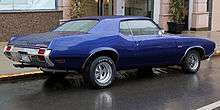
Supreme interiors were more luxurious that those of other Cutlass models, with a choice of a Custom Sport notchback bench seat with armrest in Osborne cloth or Moroccan vinyl or, at no extra cost (on coupes and convertibles only), Strato bucket seats in Moroccan vinyl. Available at extra cost with the bucket seats was a center console with floor-mounted shifter for which the Turbo Hydra-Matic transmission could also be had with the Hurst Dual-Gate shifter commonly found in the division's musclecar, the Oldsmobile 442.
For 1970 and 1971, both the Cutlass Supreme coupe and convertible were available with the Code Y-79 high performance SX option package. The "SX" option included several versions of the larger 455 cubic-inch Rocket V8 borrowed from the Olds 442 along with the cutout rear bumper and exhaust trumpets, 442's rallye suspension (optional), distinctive SX badges and other features.
A W31 option added distinctive stripes and badging, and a camshaft with increased lift and duration for the 350 engine. The W31 option was offered on Supreme coupes only in 1968, but continued on lower-line F-85 and Cutlass S coupes through 1970.
1972 was the only year in which the Cutlass Supreme notchback hardtop could be equipped with the L75 455 and M20 four speed transmission, and only 77 of these cars were produced. All 1972 L75 455/M20 cars used the larger 2.07 valves and the W30 automatic camshaft. This gave the L75 455/M20 cars 270 net horsepower, as opposed to the TH400 automatic-equipped L75 cars, which produced 250 net horsepower.
The 1972 Hurst/Olds was based on the Supreme two-door hardtop and convertible, powered by both versions of the 455 Rocket offered on the 4-4-2, along with a Turbo 400 transmission with Hurst Dual/Gate shifter. The H/O convertible also served as the Indianapolis 500 Pace Car in 1972.
1972 was also the final year for Olds to offer the Cutlass Supreme convertible, until 1990. In its final year, it was the best-selling convertible in the U.S., with 11,571 sold, or 16% of the market, beating the Eldorado and Corvette.[2] From 1973 to 1975, the only Oldsmobile convertible offered was the full-sized Delta 88 Royale.
Third generation (1973–1977)
| Third generation | |
|---|---|
.jpg) | |
| Overview | |
| Also called | Oldsmobile Cutlass Salon |
| Production | 1972–1977 |
| Model years | 1973–1977 |
| Assembly |
Arlington, Texas Lakewood Heights, Georgia |
| Body and chassis | |
| Body style |
2-door coupe 4-door sedan |
| Layout | FR layout |
| Platform | A-body |
| Related |
Chevrolet Chevelle Chevrolet Monte Carlo Chevrolet El Camino Pontiac Grand Prix Pontiac Grand Am Pontiac LeMans Oldsmobile Cutlass Buick Century Buick Regal |
| Powertrain | |
| Engine |
231 cu in (3.8 L) Buick V6 250 cu in (4.1 L) Chevrolet I6 260 cu in (4.3 L) Oldsmobile V8 350 cu in (5.7 L) Oldsmobile V8 403 cu in (6.6 L) Oldsmobile V8 455 cu in (7.5 L) Oldsmobile V8 |
| Transmission |
3-speed manual 5-speed manual 3-speed automatic |
In 1973, the Cutlass Supreme, like other GM mid-size cars, was redesigned. Hardtop models were replaced by new "Colonnade" styling with fixed center pillars. Concerns over proposed rollover standards caused many automakers to phase out their pillarless hardtops and convertibles throughout the 1970s, and the Cutlass was no exception. Despite some initial controversy over the disappearance of hardtop models, the new 1973 GM mid-sized line proved highly successful. Cutlass Supreme coupes had a unique roofline with vertical opera windows not shared with other Cutlass coupes, as well as unique front end styling.
The Cutlass line soon became Oldsmobile's biggest seller, accounting for 43% of the division's total volume in 1974, with the Cutlass Supreme coupe being the single most popular model. With rectangular headlights newly legalized in 1975, the Cutlass received a facelift for the 1976 model year featuring quad headlights and a waterfall grille. This attractive redesign boosted sales even further. The Cutlass line as a whole was America's best-selling car in 1976, helping Oldsmobile to become the only marque outside of Ford and Chevrolet to break one-million units sold. By 1977, however, GM had downsized its full-size models, and the Cutlass Supreme was now nearly identical in size to the redesigned Delta 88. That situation would last only that one year, as GM planned to downsize the Olds Cutlass and other intermediates for 1978.

In addition to the Colonnade hardtop coupe, the Cutlass Supreme was also offered in a four-door Colonnade sedan (with six-window styling and frameless door windows) as well as six-and-nine passenger station wagons - the wagons with the woodgrain exterior trim were marketed under the Vista Cruiser nameplate previously used on Oldsmobile's stretched-wheelbase station wagons with raised roof and skylights from 1964 to 1972.
The Supreme Colonnade sedan was available in 1973 as the Cutlass Salon, which was an option package that included radial tires, upgraded suspension and reclining bucket seats upholstered in corduroy or vinyl trim along with color-keyed wheelcovers - designed as sort of a European-style luxury/touring sedan similar to the Pontiac Grand Am of the same period. For 1974, the Salon package was also made available on the Supreme Colonnade coupe and in 1975, the Salon was upgraded to a separate series available in both sedan and coupe.
For 1973-74, the 350 Rocket V8 with four-barrel carburetor and 180 horsepower (130 kW) was the standard Cutlass Supreme engine with a 250-horsepower 455 Rocket offered as an option. Both three- and four-speed manual transmissions were offered in 1973, but the greatest majority of Cutlasses (including Supremes) were built with the three-speed Turbo Hydra-matic automatic transmission which became standard equipment in 1974, along with variable-ratio power steering.
The 1973-74 energy crisis resulting from the Arab Oil Embargo led Oldsmobile to introduce two new smaller engines to the Cutlass line in 1975. The Chevrolet built 250 cubic-inch inline six and three-speed manual transmission were reinstated as standard equipment on the Supreme coupe and sedan with a new Olds-built 260 cubic-inch Rocket V8 (standard on Cutlass Salon and optional on all other Cutlasses except wagons) offered as an option. However, the majority of Cutlass Supremes in 1975, 1976, and 1977 were sold with the now-optional 350 Rocket V8 and Turbo Hydra-matic automatic (still standard on wagons). The 455 Rocket V8 was optional through 1976, and replaced by a smaller 403 Rocket V8 in 1977, the same year in which a Buick-built 231 cubic-inch V6 replaced the Chevy inline six as base power in most Cutlass models.
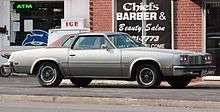
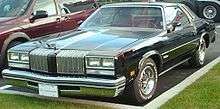
For 1976, the Cutlass Supreme Brougham coupe was added to the line, featuring a more luxurious interior trim than the regular Supreme model with pillowed crushed velour upholstery and 60/40 bench seats similar to the larger Ninety-Eight Regency. It also received quad square headlights. For 1977, the Brougham was also available as a four-door Colonnade sedan.
A five-speed manual transmission was available as an option with the 260 V8 in all models except Supreme Brougham and station wagons for 1976-77.
Fourth generation (1978–1988)
| Fourth generation | |
|---|---|
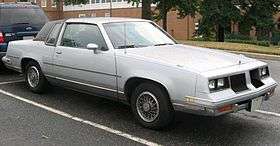 | |
| Overview | |
| Also called |
Oldsmobile Cutlass Calais (1978–1984) Oldsmobile Cutlass Salon (1985–1987) Oldsmobile Cutlass Supreme Classic (1988 only) Oldsmobile Cutlass Cruiser (1982–1983) |
| Production | 1977–1988 |
| Model years | 1978–1988 |
| Assembly |
Arlington, Texas Lakewood Heights, Georgia Pontiac, Michigan Sainte-Thérèse, Quebec |
| Body and chassis | |
| Body style |
2-door coupe 4-door sedan 4-door station wagon |
| Layout | FR layout |
| Platform |
A-body (1978–1981) G-body (1982–1988) |
| Related |
Chevrolet Malibu Chevrolet Monte Carlo Chevrolet El Camino Pontiac Grand Prix Pontiac Grand Am Pontiac LeMans Pontiac Bonneville Oldsmobile Cutlass Buick Century Buick Regal |
| Powertrain | |
| Engine |
231 cu in (3.8 L) Buick V6 260 cu in (4.3 L) Oldsmobile V8 267 cu in (4.4 L) Chevrolet V8 305 cu in (5.0 L) Chevrolet V8 307 cu in (5.0 L) Oldsmobile V8 350 cu in (5.7 L) Oldsmobile V8 260 cu in (4.3 L) Oldsmobile diesel V8 350 cu in (5.7 L) Oldsmobile diesel V8 |
| Transmission |
3-speed automatic 4-speed automatic 5-speed manual (diesel) |
| Dimensions | |
| Wheelbase | 108.0 in (2,743 mm). |
| Length | 200.0 in (5,080 mm) |
| Width | 71.6 in (1,819 mm) |
| Height | 54.9 in (1,394 mm) |
The Cutlass Supreme was downsized for 1978, along with the rest of the Cutlass line. An upscale Cutlass Calais model was added, differing from the Cutlass Supreme only in minor trim details. The new notchback Cutlass Supreme proved to be far more popular than the controversial fastback Cutlass Salon coupe and sedan introduced at the same time.
The Cutlass Calais, essentially replaced the previous Cutlass Salon series, as far as model position and content were concerned. The Calais featured reclining Strato bucket seats, center console, sport steering wheel, full instrumentation, tuned suspension with front and rear sway bars, color-keyed wheelcovers, front grilles mimicking an ice cube tray (as opposed to the waterfall style used with the Cutlass Supreme) and more.
Both the Cutlass Supreme and Calais were available with T-tops or a factory sunroof, even on the base Cutlass Supreme coupe with the factory radio delete option.
From 1978 through 1980, a high-performance 442 model was available, and for 1979 (Cutlass Calais), a special-edition performance model, the Hurst/Olds was offered. These used the Supreme's notchback body, rather than the standard fastback coupe's. Around 2,499 Hurst/Olds were produced - all were powered with an Oldsmobile 5.7L (350 cubic-inch) Rocket V8 (not the diesel engine) sourced from the full-size Delta 88 and Ninety Eight Regency. Also included in the Hurst/Olds package was the Hurst Dual/Gate shifter for the three-speed Turbo Hydra-matic transmission.
In 1978, the Cutlass line featured taillights which had a lighted Oldsmobile rocket logo in the center.
In 1979, the taillights on the Cutlass line dropped the rocket logo.
In 1980 the two-door models went back to four headlights. A 4-door notchback sedan (known as Cutlass, Cutlass LS, and Cutlass Brougham) replaced the unpopular 4-door "aeroback" Salon, which continued in two-door form for one more year. The Supreme Brougham package was available on and off throughout 1978-1988 production. This was also the first year GM introduced the OBD-I computer controlled engine management and emission control system.
The 442 option moved from the aeroback Cutlass Salon coupe body to the notchback Cutlass Calais for 1980, with content upgraded from a mere "appearance and handling" package back to a legitimate performance option with content similar to the 1979 Hurst/Olds including its 350 Rocket V8. This would be the last 442 until that model was revived in 1985, again on the Cutlass notchback body, as a successor to the 1983-84 Hurst/Olds.
In 1981, the Cutlass Supreme coupe received an aerodynamic restyle (with a "shovel-nose" front header panel), which, along with a higher rear deck, decreased air resistance by 15%.[3] It would continue with this basic design until the final rear-drive Cutlass was produced in 1988. A 4-door sedan was added to the Supreme lineup, with a new front end and a slight taillight lens restyle (resembling a touch-tone dial or Rubik's Cube - this lens style was used until 1984). It was this restyled body that (along with the Monte Carlo, Buick Regal, and Pontiac Gran Prix) ushered in the down-sized cars into NASCAR cup competition. While the Cutlass looked almost identical to the Buick Regal (which scored 35+ victories in the 1981 thru 1985 seasons), the Cutlass (like the Dodge Mirada) didn't take one checkered flag, and many teams moved away from it in 1983 to the Regal, Grand Prix, and restyled Monte Carlo SS. This was a rude awakening to Oldsmobile, which was getting used to wins on the NASCAR circuit.
In 1982, GM launched the front-wheel drive A-body, known as the Cutlass Ciera, meant as replacements for the 1978-vintage RWD A-bodies, but decided to continue selling the older models anyway. The Cutlass Supreme continued on with the RWD Cutlass sedan and station wagon (two-door Cutlasses were dropped).
The Hurst/Olds reappeared on the Cutlass Calais coupe for two years, first in 1983 as the black over silver 15th anniversary, and then as the silver over black 1984 model. Both featured chrome wheels, red striping and a high output Oldsmobile 307 V8 with 4 barrel carburetor, dual muffler exhausts and Hurst's then new three stick Lightning Rods shifter (the latter eventually becoming a magnet for thieves.) All Hurst/Olds were automatics.
The Cutlass wagon was dropped in 1984.
The 1985 Cutlass Supreme was produced by Oldsmobile and designed after the Oldsmobile Calais, which became a separate model on the GM N platform in the same year. The rear-wheel drive Cutlass Calais was renamed the Cutlass Salon (taking its name from the upscale Supreme coupe and sedan that preceded the Calais).
“ 5.0-liter V8 engine, available. The added performance that adds to the pleasure of driving.”[4] The Olds Cutlass Supreme coupe and sedan were stock with a 3.8-liter V6, 2 barrel engine, while a 5-liter V8 engine was available at extra cost. The transmission is a 3-speed automatic with torque converter clutch. The front suspension is a strut type, which is also known as the MacPherson strut. Where the rear is a multi link. Both front and rear suspension include anti-roll bars.
Brougham Coupe and Sedan - Although very similar to the original Cutlass Supreme, the Brougham is slightly better equipped. It has the same exact 3.8-liter stock engine and 3-speed transmission, but has a divided front bench seat with individual controls and the choice of velour trim in five colors. Also includes a convenience group with lamps, visor vanity mirror and chime tones. To finish off the specialization of the premium model, Oldsmobile created specific Brougham hood ornaments.[4]
1987 was the final year for the rear-wheel drive sedan, and both coupe models received a restyled header panel with composite headlights. A Buick 231 was the base motor alongside the Oldsmobile 307. For its final year, the 442 package was moved to the Supreme model.
1988 was the final year for the rear-wheel drive Cutlass Supreme. It was badged Cutlass Supreme Classic, and 27,678 were built.[5] The 2-door coupe (produced alongside the Chevrolet Monte Carlo at GM's Pontiac, Michigan plant) continued, until the new front-wheel drive version was released in December 1987. The Olds 307 was the only available engine.
High-performance engines
Two high-performance variants were created, both using a high-output version of Oldsmobile's 5.0 L (307 CID) V8 engine:
- 1983–1984 Oldsmobile Hurst/Olds
- 1985–1987 Oldsmobile 442
|
Fifth generation (1988–1997)
| Fifth generation | |
|---|---|
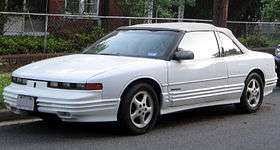 | |
| Overview | |
| Production | 1988–1997 |
| Assembly |
Doraville, Georgia Kansas City, Kansas |
| Body and chassis | |
| Body style |
2-door convertible 2-door coupe 4-door sedan |
| Layout | Transverse front-engine, front-wheel drive |
| Platform | W-body |
| Related |
Buick Regal Chevrolet Lumina Pontiac Grand Prix |
| Powertrain | |
| Engine |
2.3 L Quad-4 I4 2.8 L LB6 V6 3.1 L LH0, L82 V6 3.4 L LQ1 V6 |
| Transmission |
4-speed 4T60 automatic 5-speed Getrag manual |
| Dimensions | |
| Wheelbase | 107.5 in (2,730 mm) |
| Length |
1988–89: 192.1 in (4,879 mm) 1990–91 2dr: 192.3 in (4,884 mm) 1990–91 4dr: 192.2 in (4,882 mm) 1992–95 2dr: 193.9 in (4,925 mm) 1992–95 4dr: 193.7 in (4,920 mm) 1996–97: 193.8 in (4,923 mm) |
| Width |
1988–95: 71 in (1,803.4 mm) 1996–97 2dr: 71.5 in (1,816 mm) 1996–97 Sedan: 71.9 in (1,826 mm) |
| Height |
1988–89: 52.8 in (1,341 mm) 1990–95 Coupe: 53.3 in (1,354 mm) 1990–95 4dr: 54.8 in (1,392 mm) 1990–91 Convertible: 54.3 in (1,379 mm) 1992–95 Convertible: 54.7 in (1,389 mm) 1996–97 2-dr: 53 in (1,346 mm) 1996–97 4dr: 53.7 in (1,364 mm) |
A front-wheel-drive Cutlass Supreme based on the GM10 platform (W-body) was introduced as a coupe mid-year during the 1988 production run, while the final year of Cutlass Supreme RWD coupes were still being produced. This new FWD model shared its 107.5 in (2,730 mm) wheelbase with the Pontiac Grand Prix, Buick Regal, and Chevrolet Lumina. As part of introducing the all-new FWD Cutlass Supreme, Oldsmobile secured their place to be the car that introduced the head-up display. 250 pace car replicas were produced, including 50 custom-made convertibles; some or most were used as festival or parade cars before and during the race. These 50 were turned into convertibles by Cars and Concepts of Brighton, Michigan. These custom convertibles were the first 50 cars released to the public with a head-up display, and then subsequently recalled for reasons that remain unclear. The 1988 and 1989 models were 2-door coupes. This Cutlass body style proved to be a winner for NASCAR competition and it visited the victory circle 13 times between 1989 and 1992, when Olds ended its racing program. A sedan and a production convertible were added in 1990. Models included base (later called S), SL, and the sporty International Series. Throughout its run, the convertible was considered a separate trim level.
Further Narrative on Indy Pace Cars: In 1988 the Indianapolis Motor Speedway chose Oldsmobile to pace “The Greatest Spectacle in Racing”, with retired United States Air Force General Chuck Yeager behind the wheel. Traditionally a manufacturer builds many pace car replicas, often thousands. But in 1988 Oldsmobile chose to build only 50 Cutlass Convertible Indy Pace Car editions. All 50 (used on track on race day and in 500 Festival activities) were essentially hand built. General Motors/Oldsmobile contracted Cars and Concepts of Brighton, Michigan to build each of these 50 unique cars. Following the race 50 very select Oldsmobile dealers were given the opportunity to purchase one of these cars. The price was set at full invoice price for a standard International Series coupe (~$14,000) plus the cost of the convertible conversion (an additional $13,997). Each was highly optioned including the first ever application of Heads Up Display in an American production vehicle developed by Hughes Electronics. After the 50 were claimed, paid for and delivered to the lucky Olds dealers who said yes, the story of these cars gets more interesting. After the 50 were in the dealers’ hands across the country General Motors discovered some issue with the certification of these one-off models. Each dealer was asked to return them to GM (where they were to be destroyed) and receive full credit of their purchase price. Most of the 50 were returned for credit, but a few dealers objected and kept their cars leaving (by all accounts) less than 10 in the general population. Mr. Thomas Knobloch, a second-generation Oldsmobile dealer in Erie, Pennsylvania was one of those dealers who refused to relinquish his car. He instead held on to it as a collectible. Realizing its incredible rarity and place in both GM/Oldsmobile and Indy 500 history he drove less than 800 miles (1,300 km) over his many years of ownership. The Knobloch family sold the car after his death.
International Series models could be equipped with unique features such as quad bucket seats with dual center consoles, the driver information system and a heads-up display. A very rare Muncie 5-speed manual transmission option was paired first with the 2.8-litre (170 cu in) 60° V6 in 1988 and 1989. In 1990, a revised Getrag 5-speed manual transmission option was available for the high-output Quad-4 I4 and the DOHC 3.4-litre (210 cu in) 60° V6 in 1991 and 1992. The entire line was restyled for 1992, with coupes and convertibles gaining distinctive "mini-quad" headlamps shared with the Pontiac Grand Prix Coupe. A driver's side airbag became standard in 1994, and a new ergonomically curved dashboard with dual airbags debuted in 1995.
The lineup was gradually pared down over time. The Quad-4 was last produced during the 1991 model year; the manual transmission option during 1992; the International Series during 1993; the S Series during 1994; the convertible during 1995; and the 3.4 L V6 engine option during 1996. The Cutlass Supreme ceased production at the end of the 1997 model year. That same year, an N-body Cutlass (actually a badge-engineered Malibu) was introduced to replace the Ciera, but this model lasted just three years. The Cutlass Supreme's place in the Oldsmobile line was taken by the 1998 Intrigue, built on the next version of the W platform. The Cutlass Supreme ended production in April 1997.
The W-body Cutlass Supreme was built in Doraville, Georgia from 1988 to 1995, and at the Fairfax Plant in Kansas City, Kansas from 1996 to 1997. The first 1988 Cutlass Supreme rolled off the assembly line on January 13, 1988. The last Cutlass Supreme convertible was completed on February 15, 1995. The reason for this is that the last 34,743 cars built in Doraville were sedans, the coupe production was sent to Fairfax, Kansas around March 1, 1995 and Cars and Concepts did not have a facility near Fairfax.
Engines
| Engine | Years | Power | Torque |
|---|---|---|---|
| 2.8 L (173 cu in) LB6 V6 | 1988–1989 | 130 hp (97 kW) | 170 lb·ft (230 N·m) |
| 3.1 L (191 cu in) LH0 V6 | 1989–1993 | 140 hp (104 kW) | 185 lb·ft (251 N·m) |
| 2.3 L (138 cu in) Quad-4 (LD2) I4 | 1990–1991 | 160 hp (119 kW) | 152 lb·ft (206 N·m) |
| 2.3 L (138 cu in) Quad-4 (LG0) I4 | 1990 | 180 hp (134 kW) | 160 lb·ft (217 N·m) |
| 3.1 L (191 cu in) L82 V6 | 1992–1997 | 160 hp (119 kW) | 185 lb·ft (251 N·m) |
| 3.4 L (204 cu in) LQ1 V6 | 1991–1995 | 210 hp (157 kW) | 215 lb·ft (292 N·m) |
| 3.4 L (204 cu in) LQ1 V6 | 1996 | 215 hp (160 kW) | 220 lb·ft (298 N·m) |
Gallery
 1990–1991 Cutlass Supreme sedan
1990–1991 Cutlass Supreme sedan 1990 Oldsmobile Cutlass Supreme coupe
1990 Oldsmobile Cutlass Supreme coupe 1992–1995 Oldsmobile Cutlass Supreme coupe
1992–1995 Oldsmobile Cutlass Supreme coupe
See also
- Oldsmobile Cutlass
- Oldsmobile Cutlass Ciera
- Oldsmobile Cutlass Calais
- Oldsmobile 442
- Oldsmobile Hurst/Olds
References
- ↑ Norbye, Jan P. (October 1965). "The 1966 cars". Popular Science. 187 (4): 79. Retrieved 2 December 2015.
- ↑ Flory, J. "Kelly", Jr. American Cars 1960-1972 (Jefferson, NC: McFarland & Coy, 2004), p.864.
- ↑ Stark, Harry A, ed. (1981). Ward's Automotive Yearbook 1981. Ward's Communications, Inc. p. 190.
- 1 2 Oldsmobile. 1985 Oldsmobile. Fredric Wisconsin: Oldsmobile, 1985. Print.
- ↑ Ward's Automotive Yearbook 1989. Ward's Communications, Inc. 1989.
External links
- 442.com
- Oldsmobile Club of America
- 1970-1971 Cutlass Supreme SX registry
- 1972 Oldsmobile "V Code" Registry (455/M20 cars)
- w-body.com
- GM W Body
| Wikimedia Commons has media related to Oldsmobile Cutlass Supreme. |
| « previous — Oldsmobile road car timeline, 1980s–2004 | |||||||||||||||||||||||||
|---|---|---|---|---|---|---|---|---|---|---|---|---|---|---|---|---|---|---|---|---|---|---|---|---|---|
| Type | 1980s | 1990s | 2000s | ||||||||||||||||||||||
| 0 | 1 | 2 | 3 | 4 | 5 | 6 | 7 | 8 | 9 | 0 | 1 | 2 | 3 | 4 | 5 | 6 | 7 | 8 | 9 | 0 | 1 | 2 | 3 | 4 | |
| Compact car | Starfire | Firenza | |||||||||||||||||||||||
| Omega | Cutlass Calais | Achieva | Alero | ||||||||||||||||||||||
| Mid-size car | Cutlass | Cutlass Ciera | Cutlass | ||||||||||||||||||||||
| Cutlass Supreme | Cutlass Supreme | Intrigue | |||||||||||||||||||||||
| Mid-size station wagon | Cutlass Cruiser | Cutlass Ciera Cruiser | |||||||||||||||||||||||
| Full-size car | Eighty-Eight | Eighty-Eight | Eighty-Eight | ||||||||||||||||||||||
| LSS | |||||||||||||||||||||||||
| Ninety-Eight | Ninety-Eight | Ninety-Eight | Regency | ||||||||||||||||||||||
| Aurora | Aurora | ||||||||||||||||||||||||
| Full-size station wagon | Custom Cruiser | Custom Cruiser | |||||||||||||||||||||||
| Personal luxury car | Toronado | Toronado | |||||||||||||||||||||||
| Minivan | Silhouette | Silhouette | |||||||||||||||||||||||
| SUV | Bravada | Bravada | Bravada | ||||||||||||||||||||||


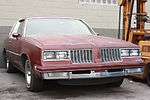
.jpg)


